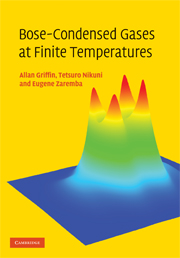Book contents
- Frontmatter
- Contents
- Preface
- 1 Overview and introduction
- 2 Condensate dynamics at T = 0
- 3 Coupled equations for the condensate and thermal cloud
- 4 Green's functions and self-energy approximations
- 5 The Beliaev and the time-dependent HFB approximations
- 6 Kadanoff–Baym derivation of the ZNG equations
- 7 Kinetic equation for Bogoliubov thermal excitations
- 8 Static thermal cloud approximation
- 9 Vortices and vortex lattices at finite temperatures
- 10 Dynamics at finite temperatures using the moment method
- 11 Numerical simulation of the ZNG equations
- 12 Simulation of collective modes at finite temperature
- 13 Landau damping in trapped Bose-condensed gases
- 14 Landau's theory of superfluidity
- 15 Two-fluid hydrodynamics in a dilute Bose gas
- 16 Variational formulation of the Landau two-fluid equations
- 17 The Landau–Khalatnikov two-fluid equations
- 18 Transport coefficients and relaxation times
- 19 General theory of damping of hydrodynamic modes
- Appendix A Monte Carlo calculation of collision rates
- Appendix B Evaluation of transport coefficients: technical details
- Appendix C Frequency-dependent transport coefficients
- Appendix D Derivation of hydrodynamic damping formula
- References
- Index
4 - Green's functions and self-energy approximations
Published online by Cambridge University Press: 06 October 2009
- Frontmatter
- Contents
- Preface
- 1 Overview and introduction
- 2 Condensate dynamics at T = 0
- 3 Coupled equations for the condensate and thermal cloud
- 4 Green's functions and self-energy approximations
- 5 The Beliaev and the time-dependent HFB approximations
- 6 Kadanoff–Baym derivation of the ZNG equations
- 7 Kinetic equation for Bogoliubov thermal excitations
- 8 Static thermal cloud approximation
- 9 Vortices and vortex lattices at finite temperatures
- 10 Dynamics at finite temperatures using the moment method
- 11 Numerical simulation of the ZNG equations
- 12 Simulation of collective modes at finite temperature
- 13 Landau damping in trapped Bose-condensed gases
- 14 Landau's theory of superfluidity
- 15 Two-fluid hydrodynamics in a dilute Bose gas
- 16 Variational formulation of the Landau two-fluid equations
- 17 The Landau–Khalatnikov two-fluid equations
- 18 Transport coefficients and relaxation times
- 19 General theory of damping of hydrodynamic modes
- Appendix A Monte Carlo calculation of collision rates
- Appendix B Evaluation of transport coefficients: technical details
- Appendix C Frequency-dependent transport coefficients
- Appendix D Derivation of hydrodynamic damping formula
- References
- Index
Summary
In Chapter 3, we introduced a simple but reasonable approximation for the nonequilibrium dynamics of a Bose-condensed gas based on a generalized GP equation coupled to a kinetic equation. In Chapters 4–7, we turn to the question of how to derive such coupled equations for the condensate and noncondensate components in a way that gives a deeper understanding of the ZNG theory. Chapters 4–7 involve an introduction to Green's functions and field theoretic techniques for nonequilibrium problems. These provide the natural language and formalism to deal with the many subtle aspects of a Bose-condensed gas at finite temperatures. These four chapters are fairly technical. This chapter is mainly based on Kadanoff and Baym (1962) and Imamović-Tomasović (2001). Readers who are not interested in these questions can go straight to Chapter 8, which begins the discussion of applications of the ZNG coupled equations given in Chapter 3.
Overview of Green's function approach
To derive a microscopic theory of the nonequilibrium behaviour of a dilute weakly interacting Bose-condensed gas at finite temperatures, there are several different approaches available in the literature. We will use the wellknown Kadanoff–Baym (KB) nonequilibrium Green's function method. The generalization of this formalism to a Bose-condensed system was first considered by Kane and Kadanoff (1965), whose goal was to derive the Landau two-fluid hydrodynamic equations for a system with a Bose broken symmetry.
The general problem consists of how to calculate the nonequilibrium response of a system induced by an external (space- and time-dependent) perturbation. In response to such an external perturbation, many interesting physical phenomena appear, including the excitation of collective modes and various transport processes.
- Type
- Chapter
- Information
- Bose-Condensed Gases at Finite Temperatures , pp. 54 - 80Publisher: Cambridge University PressPrint publication year: 2009



